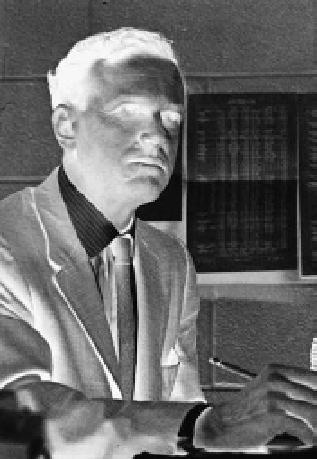Information Technology Reference
In-Depth Information
Wilkes said later:
It resembled the EDVAC in that it was a serial machine using mercury
tanks, but that was all. When I was at the Moore School the EDVAC
design did not exist, except maybe in Eckert's head.
13
His visit to the Moore School had had a huge impact on Wilkes and
he left with an enduring respect for Ekert and Mauchly and said “They
remain my idols.”
14
He also spent time with John Mauchly after the lec-
tures and acknowledged this action as a “wonderful, wonderful piece of
generosity.”
15
Fig. 2.23. A bit pattern on a cathode ray
tube used in “Williams” memory.
Computer memory technologies
Williams and Kilburn and their team designing the Manchester
Baby developed an internal memory using cathode ray tubes, the same technology as was then used in radar
screens and televisions. In these so-called Williams Tubes, the electron guns could make charge spots on the
screen that corresponded to binary 1 and 0 values. Since the charge would dissipate after a fraction of a sec-
ond, the screen needed to be refreshed in order to retain the record of the bits. The Baby had four Williams
Tubes: one to provide storage for 32-by-32-bit words; a second to hold a
32-bit “register,” in which the intermediate results of a calculation could
be stored temporarily; and a third to hold the current program instruc-
tion and its address in memory. The fourth tube, without the storage
electronics of the other three, was used as the output device and could
display the bit pattern of any selected storage tube (
Fig. 2.23
). Williams
Tubes were used as storage in the commercial version of the Baby, the
Ferranti Mark 1, as well as in such U.S. computers as the Princeton IAS
and the IBM 701.
Another early memory storage technology, originally suggested
by Eckert, was based on the idea of a mercury delay-line - a thin tube
filled with mercury that stores electronic pulses in much the same way
as a hiker in a canyon can “store” an echo. A pulse represented binary
1; no pulse, binary 0. The pulses bounced from end to end and could be
created, detected, and reenergized by electronic components attached
to the tube. The EDSAC, built by Wilkes and his team in Cambridge,
U.K., used mercury delay-lines. Wilkes had the good fortune to recruit a
remarkable research physicist at Cambridge, Tommy Gold (
B.2.7
), who
had been working on mercury delay-lines for radar during the war. Gold's
knowledge and experience were invaluable in constructing large, five-
foot “tanks” of mercury that were long enough to store enough pulses
but were also precision engineered to an accuracy of a thousandth of an
inch. Each mercury-filled tube could store 576 binary digits and the main
store consisted of thirty-two such tubes, with additional tubes acting as
central registers within the processor.
Mercury delay-lines and Williams Tubes were widely used until
the early 1950s, when Jay Forrester (
B.2.8
), working at MIT, invented
the magnetic core memory (
Fig. 2.24
). This device consisted of small
B.2.7. Austrian-born astrophysicist
Tommy Gold (1920-2004) did important
work in many scientific and academic
fields. His knowledge of mercury delay-
line storage from his experience with
radar during the war was very helpful to
Wilkes. Gold made major contributions
to astronomy and cosmology as well
as to radar technology. Gold was first
to propose the now generally accepted
theory that pulsars are rotating neutron
stars.




Search WWH ::

Custom Search